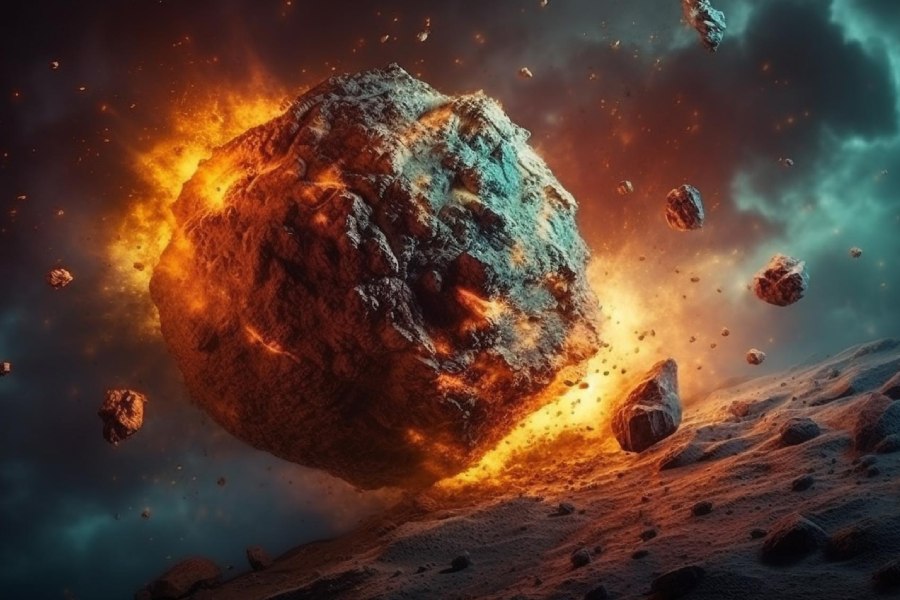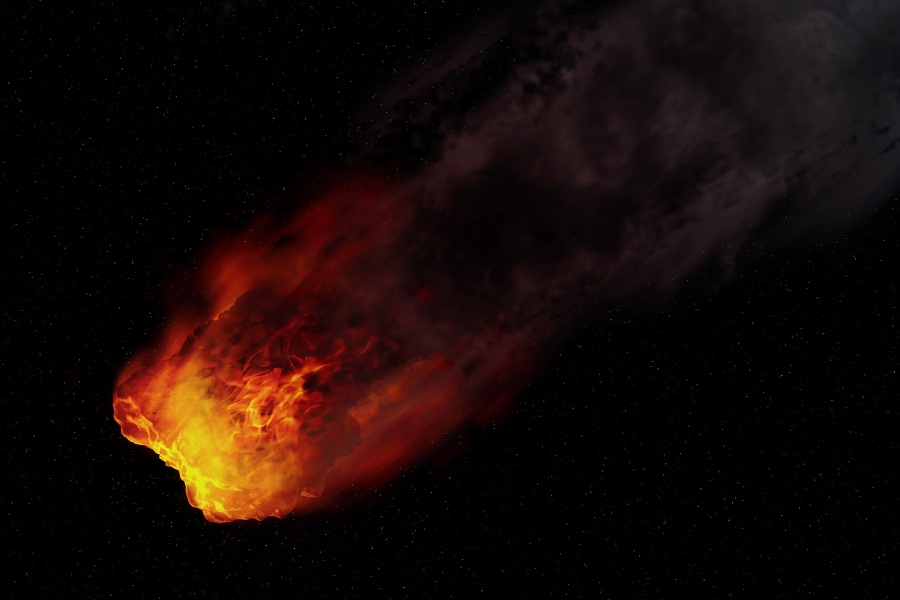Have you ever wondered where those streaks of light in the night sky come from? When bits of dust and rock enter Earth’s atmosphere, they burn up and create brief fiery displays we call meteors or shooting stars. But where do these pieces of cosmic material originate? Where do meteoroids come from?
This article will look at the various sources that scientists have identified as contributors to our meteor showers here on Earth. We’ll learn about comets and asteroids – two types of small bodies orbiting the Sun that leave trails of debris in their paths.
As Earth travels through these particle trails at certain times of the year, we experience meteor showers. With information on cosmic recycling processes and meteoroid composition, we’ll piece together an answer to that age-old question – where do meteoroids come from?
Where Do Meteoroids Come From?
So, where do meteoroids come from, and how do meteoroids form? Comets and asteroids are two major sources. As a comet’s orbit brings it close to the sun, ice melts and releases dust. This dust trails behind, crossing Earth’s path.
Asteroids in the belt between Mars and Jupiter occasionally collide. Fragments from these crashes drift inward. Some intersect Earth’s orbit as meteoroids.
Another source is disintegrated early worlds. Billions of years ago, collisions shattered developing planets and moons. Debris from these ancient crashes still floats through the Solar System. Some eventually make their way to Earth’s atmosphere.

What are meteoroids?
Meteoroids are small rocky or metallic celestial bodies ranging in size from microscopic dust to boulders a few meters wide, originating from larger parent bodies like asteroids, comets, or the Moon.
As they orbit the Sun, some intersect Earth’s atmosphere and burn up spectacularly as “shooting stars“, revealing their nature and origins. Understanding meteoroids provides insights into early Solar System dynamics and the evolutionary processes that shaped the planets.
Classification of Meteoroids
Meteoroids are loosely aggregated particles ranging from microscopic grains to boulders less than 10 meters in diameter. They occupy the size spectrum between interstellar dust and larger asteroids. Based on their internal composition and structure.
Meteoroids can be organized into three principal types – rocky, metallic, and stony-iron – with gradations in between. Like pieces of a puzzle, each meteoroid holds clues about its origin.
Diverse roles in cosmic processes
As meteoroids traverse interplanetary space, they participate in diverse phenomena that have influenced cosmic evolution over billions of years. These include continually cratering ancient surfaces of planets, moons, and asteroids.
Delivering vast quantities of water, organic compounds, and prebiotic chemistry essential for life’s emergence on Earth. Brilliant meteoric displays in Earth’s sky highlight the dynamics of cometary streams such as the Orionids and Perseids. The influences of tiny meteoroids span from microscopic to global scales.
Deciphering distinct parent sources
Determining whether a meteoroid originated from a particular asteroid family, long-period comet, or ancient lunar impact requires detailed analysis.
This analysis examines chemical, mineral, isotopic, and structural properties. It looks for signatures unique to each source tied to its distinct stellar nursery and subsequent journey through space and time.
Where Do Meteoroids Come From
Asteroids – Building blocks of meteoroids
Asteroids as pivotal contributors
Asteroids produce many meteoroids over billions of years mainly through continual collisions that smash into them. These impacts eject rocky material outward in all directions at high velocities. The fragments spread through space and become interplanetary meteoroids crossing our solar system.
Collisions act like gigantic hammers that smash asteroids into countless bits and pieces by transferring extreme amounts of kinetic energy that pulverizes them.
Broken fragments created in huge impact events are flung outward at high speeds in varied trajectories as backlash from the blows. Many bits of ejecta survive the interplanetary journey as rocky meteoroids circulating through the Solar System.
Connection between asteroid collisions and meteoroid formation
Collisions act as tremendously powerful hammer blows that smash asteroids into bits and pieces by imparting extreme kinetic energy into them upon contact.
The imparted energy gets absorbed by asteroids and channeled into pulverizing them into countless fragments. These fragments, big and small, are flung outward at varying trajectories in the aftermath.
Many bits of rocky debris from the catastrophic collisions eventually go into independent orbits around the Sun as swarms of interplanetary meteoroids over timescales of thousands to millions of years.
Most circulating meteoroids eventually crash into planets further down the road. But some enter Earth’s atmosphere spectacularly burning up as bright fireballs before they strike the surface.
Types and classifications of asteroids
There are three main types of asteroids based on composition – rocky silicates, metallic iron and nickel, and a mixture of rock and metal. Asteroids vary greatly in their properties and origins, with no two exactly alike, providing clues to early Solar System formation processes over four billion years ago.
Most asteroids are found in the asteroid belt between the orbits of Mars and Jupiter, which contains millions of bodies orbiting the Sun. Some asteroids have orbits crossing planetary paths, occasionally impacting them and delivering water.
In addition, some asteroids have their own small moons orbiting them as mini binary systems with gravitational interactions continually shaping their paths.
Large asteroids like Vesta and Ceres have generated numerous meteoroids over billions of years from repeated impacts ejecting rocky debris. Meteor showers on Earth often originate from dust released in this manner.

Comets – Another source of meteoroids
Comets produce many meteoroids over their lifespans. Their icy nuclei shed debris through sublimation when approaching the Sun. This generates trails of meteoroidal material orbiting in the inner Solar System.
As ancient relics from the outer Solar System, insights into comets further our understanding of early formation epochs. Comet-derived meteoroids constitute a sizable fraction of impacting Earth.
The connection between comets and meteoroids arises from comets shedding mass when their frozen volatiles vaporize. This generates debris tails and trails of dust particles large and small emanating outwards.
The Asteroid Belt
The asteroid belt orbits between Mars and Jupiter, containing millions of rocky bodies left over from the early stages of planet formation. Shaped like a doughnut, the belt marks a divide where growing planets accreted matter closer to the Sun billions of years ago according to models.
The asteroids represent building blocks of rocky worlds that did not get incorporated into planets. The belt continues to deliver key compounds like water to the inner planets through meteoroid impacts.
A leading view hypothesizes the asteroid belt zone originally harbored one or more sizable proto-planets forming early on from the solar nebula. A major collision disrupted the planetesimal before it fully developed into a larger body. The debris over time consolidated into current asteroids through accretion.
This theory explains why a planet did not culminate between Mars and Jupiter’s orbits as would be anticipated around the young Sun. The primordial impact shaped our planetary system’s architecture and asteroid meteoroid dynamics persisting today.
Meteoroid sources in the asteroid belt
Mechanisms of meteoroid production
Within the asteroid belt, meteoroids are generated mainly from collisions between asteroids smashing and fragmenting the rocky bodies through extreme kinetic energy transfer.
Additional mechanisms producing meteoroids include disruptive gravitational encounters between asteroids in crowded orbits causing tidal stresses beyond their weak limits and thus tearing them apart.
Over billions of years, the above processes have yielded countless meteoroids from primordial asteroid bodies. Ongoing collisions ensure meteoroids and asteroid fragments will persist as main belt occupants for eons.
Exploration of specific asteroid sources
Certain asteroids currently produce more meteoroids than others. For example, large asteroids with higher gravity attract more collisions from smaller orbiting bodies. Protoplanet Vesta’s basaltic crust also more readily yields meteoroids after huge impacts compared to metallic asteroids.
Studying asteroid crater chains helps uncover relative meteoroid production rates correlated with asteroid size, mass, orbit, and spectral type. Missions to gather data on asteroid geology directly and sample returning meteorite fragments back to labs on Earth for analysis will uncover new connections between diverse Solar System bodies.
Lunar Meteorite
Lunar meteorites originate from Earth’s Moon. Only about 340 lunar meteorites have been identified out of over 130,000 collected space rocks. Studying lunar meteorites provides insights into the Moon’s evolution and makeup without needing to gather them directly via missions.
Formation and composition of lunar meteorite
They are created when a powerful asteroid or comet collisions eject Moon rocks into space. They come from the Moon’s basalt crust and upper mantle layers, unlike meteorites from other bodies’ cores or deep layers.
While the Moon formed from early Earth collision debris, lunar rocks became compositionally distinct over geological history. Some lunar meteorites have trace water signatures providing clues about the Moon’s past water migration still not fully grasped.

Conclusion
Where do meteoroids come from? Our exploration has traced meteoroids across their cosmic journeys to uncover where these mysterious messengers come from. We have investigated how asteroids, comets, and the Moon generate them through an array of mechanisms reflecting their origins.
Collisions, outgassing, and tidal disruption – are all pivotal to elucidating the birthplaces of meteoroids today. Studying pieces of meteorites that fall to Earth can give us clues about their different origins and how they formed. Meteoroids arrive either from asteroid families occupying the main belt or from relic comets shedding ice and debris in the distant Kuiper belt.
These small yet numerous messengers come from beyond our Solar System. Studying them allows a deeper appreciation of the web of dynamics that produced them since the origins of our system.
